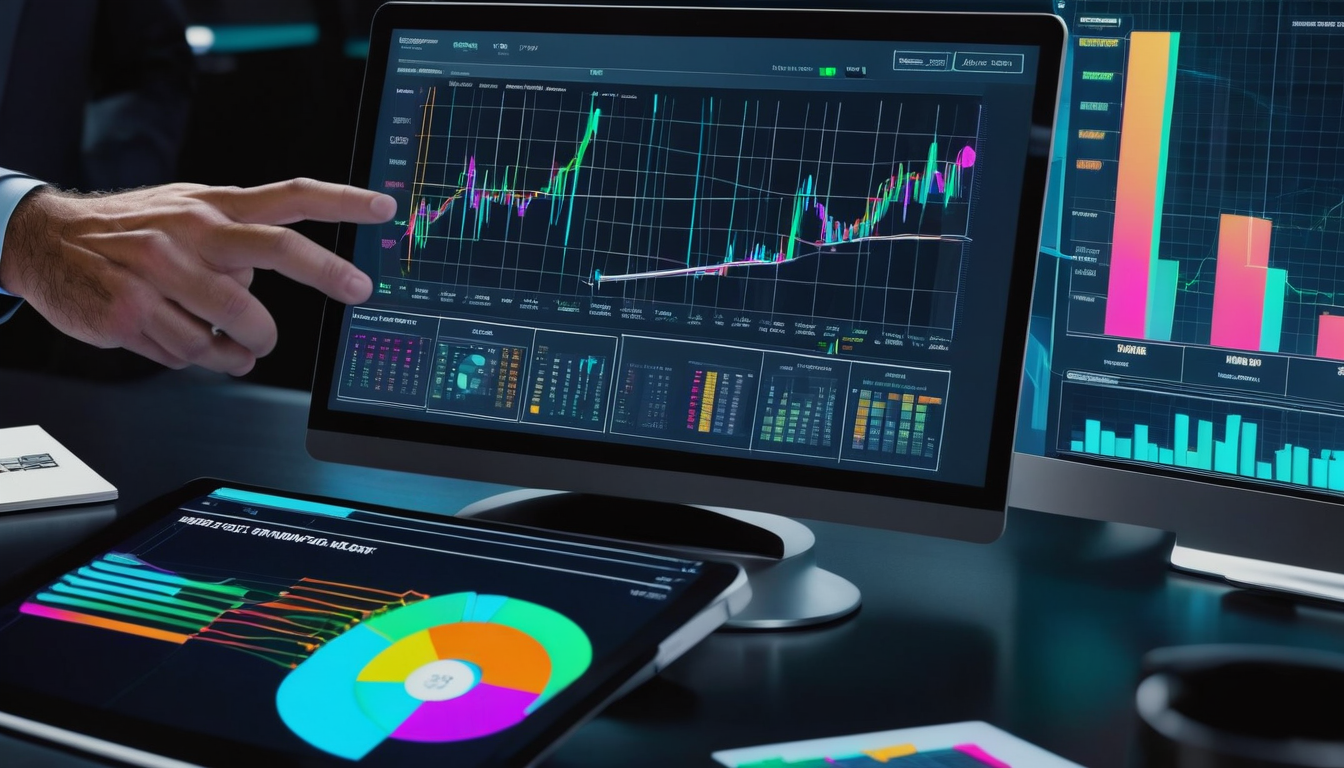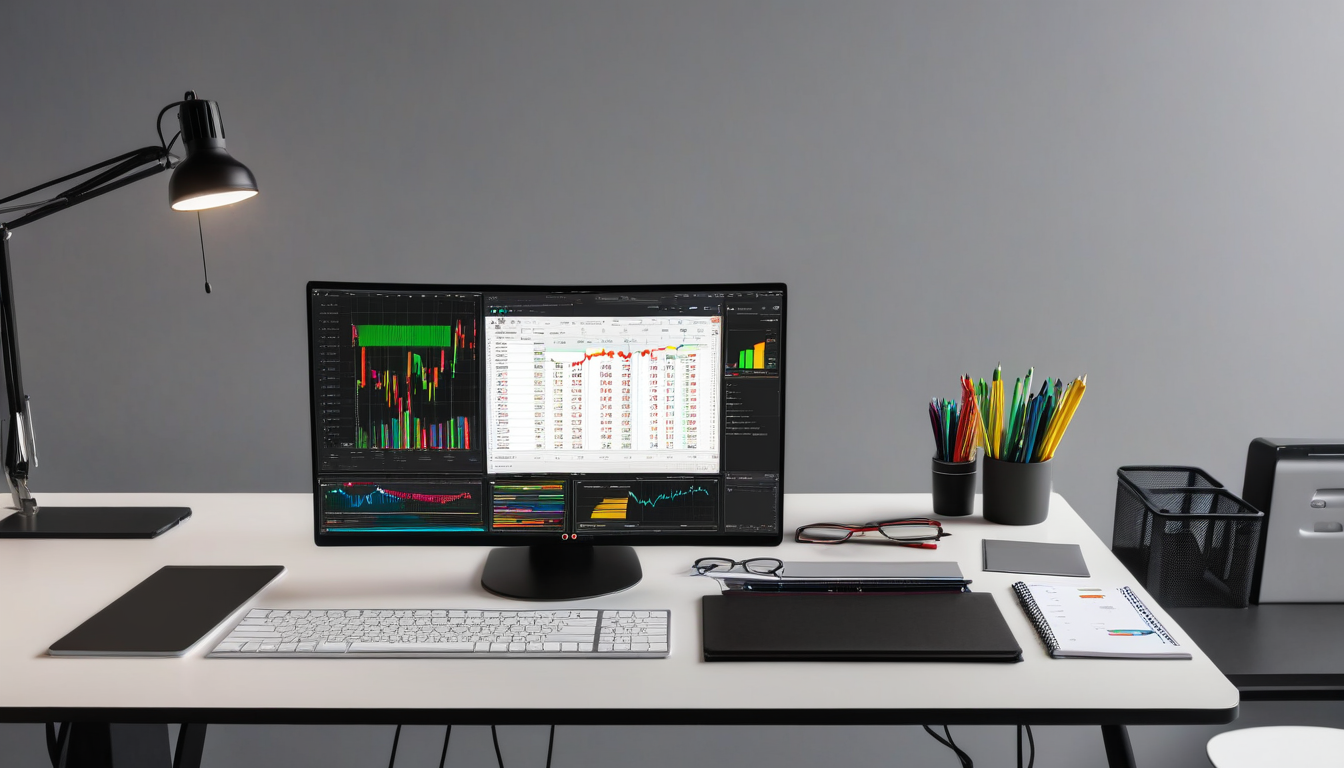The Best AI-Powered Investment and Trading Tools

In today’s fast-paced financial world, AI-powered investment and trading tools are revolutionizing the way we approach investing. Imagine having a personal financial advisor that works around the clock, analyzing data and making predictions faster than any human could. That’s exactly what these tools offer! They leverage advanced algorithms to sift through mountains of data, identifying trends and opportunities that can significantly enhance your investment strategy. With the right tools, you can not only maximize your returns but also minimize risks associated with market volatility.
The integration of artificial intelligence into finance is more than just a trend; it’s a game-changer. These tools can process vast datasets at lightning speed, providing insights that were previously unimaginable. For instance, AI can analyze historical price movements, news articles, and social media sentiment to forecast market trends. The result? A more informed and strategic approach to investing that can lead to higher profits and lower losses.
To illustrate the effectiveness of these tools, let’s take a look at some of the top AI investment platforms available today. Each platform offers unique features tailored to different types of investors. Here’s a quick comparison:
| Platform Name | Key Features | Pricing |
|---|---|---|
| Wealthfront | Automated investing, tax-loss harvesting | 0.25% annual fee |
| Betterment | Personalized financial advice, goal-based investing | 0.25% to 0.40% annual fee |
| Trade Ideas | Real-time market analysis, AI-powered alerts | $99/month |
As you explore these options, keep in mind that while AI tools can enhance your trading efficiency, they are not foolproof. There are inherent risks involved, such as algorithmic biases and unpredictable market fluctuations. Therefore, it’s crucial to understand how these tools work and incorporate them into a well-rounded investment strategy.
In summary, AI-powered investment and trading tools are paving the way for smarter investing. They offer a blend of speed, accuracy, and data-driven insights that can transform your financial journey. So, are you ready to embrace the future of investing?

Understanding AI in Finance
Artificial intelligence is no longer a futuristic concept; it has become a driving force in the finance sector. Imagine having a virtual assistant that can sift through mountains of data at lightning speed, spotting trends and making predictions that would take a human analyst weeks to uncover. This is precisely what AI does in the realm of finance. By employing sophisticated algorithms, AI can analyze vast datasets, enabling smarter investment decisions and enhancing trading performance.
AI’s ability to process and analyze data is revolutionizing how investors approach the market. It can evaluate historical data, assess current market conditions, and even predict future trends. This capability allows for more informed decision-making, which is crucial in a landscape where every second counts. For instance, AI can identify patterns that indicate potential stock price movements, giving traders a significant edge. The role of AI in finance can be summarized in the following key areas:
- Data Analysis: AI algorithms can analyze complex datasets quickly, identifying trends and anomalies that human analysts might miss.
- Predictive Analytics: By leveraging machine learning, AI can forecast market movements based on historical data.
- Risk Management: AI tools can assess the risk associated with various investment strategies, helping investors make more calculated decisions.
To further illustrate the transformative impact of AI in finance, let’s take a look at a simple comparison of traditional analysis versus AI-driven analysis:
| Aspect | Traditional Analysis | AI-Driven Analysis |
|---|---|---|
| Speed | Slow, requires manual data processing | Fast, processes vast amounts of data in seconds |
| Accuracy | Subject to human error | High accuracy, minimizes human bias |
| Scalability | Limited by human capacity | Highly scalable, can analyze millions of data points |
As we delve deeper into the world of AI in finance, it’s essential to recognize the potential challenges that come with it. For example, while AI can significantly enhance decision-making, it is not infallible. There are instances where algorithmic biases can lead to poor investment choices, underscoring the importance of human oversight. As we continue to explore the integration of AI tools into investment strategies, understanding these nuances will be key to leveraging their full potential.
In conclusion, AI is reshaping the financial landscape, providing tools that enhance investment strategies and trading efficiency. As we embrace this technology, the possibilities are truly exciting. Are we ready to harness the power of AI to revolutionize our investment approaches?

Top AI Investment Platforms
When it comes to navigating the complex world of investing, the right tools can make all the difference. AI investment platforms are revolutionizing how we approach trading and portfolio management. These platforms harness the power of artificial intelligence to provide users with automated trading options, personalized investment advice, and comprehensive portfolio management. Imagine having a financial advisor that never sleeps, constantly analyzing market trends and data to help you make informed decisions. Sounds great, right?
Several leading AI investment platforms have emerged in recent years, each offering unique features and benefits. For instance, some platforms focus on automated trading, while others provide in-depth market analysis and insights. Here are a few notable platforms that stand out:
| Platform Name | Key Features | Pricing |
|---|---|---|
| Wealthfront | Automated investing, tax-loss harvesting, financial planning | 0.25% annual fee |
| Betterment | Goal-based investing, personalized advice, tax-efficient strategies | 0.25% to 0.40% annual fee |
| Robinhood | Commission-free trading, simple interface, cryptocurrency trading | Free, with premium options available |
| Trade Ideas | Real-time market data, AI-powered trade suggestions, backtesting | From $99/month |
Each of these platforms has its own strengths, catering to different types of investors. Whether you’re a seasoned trader or just starting out, there’s an AI investment platform that can meet your needs. But what should you look for when choosing the right one? Here are some key considerations:
- User Interface: A clean and intuitive interface can make a huge difference in your trading experience.
- Features: Look for platforms that offer features aligned with your investment goals.
- Customer Support: Reliable support can help you navigate any issues that arise.
In conclusion, the are designed to enhance your trading experience by leveraging advanced algorithms and data analysis. By choosing the right platform, you can maximize your returns and minimize your effort. So, why not dive into the world of AI-powered investing? You might just find that it transforms your financial journey.
“Investing without research is like playing poker without looking at your cards.” – Unknown

AI Trading Bots Explained
AI trading bots are revolutionizing the way we approach the financial markets. These automated systems are designed to execute trades based on predetermined algorithms, allowing traders to capitalize on market opportunities without the need for constant monitoring. Imagine having a tireless assistant that analyzes market data, identifies trends, and executes trades all while you enjoy your morning coffee. Sounds great, right?
At their core, AI trading bots utilize complex algorithms and machine learning techniques to analyze vast amounts of data. This enables them to make informed trading decisions at lightning speed, far surpassing human capabilities. What’s fascinating is how these bots learn from past market behavior, continuously improving their strategies over time. It’s like having a personal coach that never sleeps!
Here are some key functionalities of AI trading bots:
- Data Analysis: Bots can process and analyze large datasets from various sources, including historical data, market news, and social media sentiment.
- Trade Execution: They can execute trades much faster than a human trader could, ensuring that you don’t miss out on critical market movements.
- Risk Management: Many bots come equipped with risk management features, allowing you to set stop-loss limits and manage your portfolio effectively.
To illustrate how AI trading bots operate, let’s take a look at a simple comparison between manual trading and AI trading bots:
| Feature | Manual Trading | AI Trading Bots |
|---|---|---|
| Speed of Execution | Slower, dependent on trader’s reaction time | Instantaneous, executes trades in milliseconds |
| Emotion Influence | Prone to emotional decisions | Emotionless, purely data-driven |
| Market Analysis | Limited to trader’s knowledge and experience | Access to vast datasets and advanced analytics |
While the benefits of using AI trading bots are significant, it’s essential to understand that they are not a guaranteed path to success. Market volatility, algorithmic biases, and unforeseen events can impact their performance. As the saying goes, “don’t put all your eggs in one basket.” It’s crucial to combine the use of AI trading bots with sound trading strategies and risk management practices.
In conclusion, AI trading bots represent a significant shift in how traders can approach the markets. They provide a unique blend of speed, efficiency, and data-driven decision-making that can enhance trading performance. By understanding their functionalities and integrating them into your trading strategy, you can potentially unlock new avenues for success in the financial landscape.

Benefits of AI in Trading
In the fast-paced world of trading, AI tools have emerged as game-changers, offering a plethora of benefits that can significantly enhance trading strategies. Imagine having a personal assistant that can analyze mountains of data in mere seconds, providing you with insights that would take a human days to uncover. This is the power of artificial intelligence in trading, and it’s revolutionizing how traders operate.
One of the most significant advantages of AI in trading is its accuracy. AI algorithms can analyze historical data and identify patterns that humans might miss. For instance, an AI system can process thousands of data points, from market trends to economic indicators, to predict price movements with remarkable precision. This capability not only boosts confidence but also helps traders make informed decisions that align with their investment goals.
Moreover, speed is another critical benefit. In trading, timing is everything. AI tools can execute trades at lightning speed, often in fractions of a second. This is particularly beneficial in high-frequency trading, where milliseconds can make a substantial difference between profit and loss. With AI, traders can capitalize on fleeting market opportunities that would otherwise slip away.
Additionally, AI trading tools can handle vast datasets more efficiently than humans. They can sift through enormous amounts of information, including news articles, social media sentiments, and market analytics, to gauge the market’s pulse. This ability to analyze diverse data sources provides a more holistic view of market conditions, which is invaluable for developing effective trading strategies.
Here are some key benefits of using AI in trading:
- Enhanced Decision-Making: AI provides data-driven insights that help traders make better decisions.
- Emotion-Free Trading: AI systems operate without emotional biases, leading to more rational trading choices.
- Risk Management: AI can assess risk levels and suggest adjustments to portfolios to mitigate potential losses.
However, it’s essential to remember that while AI tools offer significant advantages, they are not foolproof. Traders should remain vigilant and continuously educate themselves about market dynamics. As the saying goes, “Even the best tools are only as good as the hands that wield them.” Thus, integrating AI into trading strategies can yield impressive results when combined with human expertise and market knowledge.
In conclusion, the are undeniable. From enhanced accuracy and speed to the ability to analyze vast datasets, AI tools are paving the way for smarter trading strategies. As technology continues to evolve, the potential for AI to transform the trading landscape will only grow, making it an exciting time to be involved in the financial markets.
| Benefit | Description |
|---|---|
| Accuracy | AI algorithms analyze data to identify patterns and predict price movements with precision. |
| Speed | AI can execute trades in milliseconds, allowing traders to capitalize on market opportunities quickly. |
| Data Handling | AI systems can process vast datasets, offering a comprehensive view of market conditions. |

Risks and Challenges
While AI-powered investment and trading tools offer remarkable opportunities for enhanced decision-making and efficiency, they are not without their . Investors must tread carefully, as the financial landscape can be unpredictable, and reliance on technology can sometimes lead to unforeseen consequences. One of the primary concerns is the potential for market volatility. Algorithms that drive AI tools may react to market changes in ways that can exacerbate fluctuations, leading to unexpected losses.
Another significant challenge is algorithmic bias. AI systems are trained on historical data, and if that data contains inherent biases, the algorithms can perpetuate these biases in their predictions and decisions. This can skew investment strategies and lead to poor outcomes. Moreover, the complexity of these algorithms can make them somewhat of a “black box,” where even experienced investors may struggle to understand the decision-making process behind trades.
To illustrate these risks, consider the following table that outlines some of the key challenges associated with AI investment tools:
| Challenge | Description |
|---|---|
| Market Volatility | AI tools may react to sudden market changes, leading to increased volatility. |
| Algorithmic Bias | Data biases can influence AI decisions, resulting in skewed predictions. |
| Lack of Transparency | The complexity of algorithms can make it difficult to understand decision-making. |
| Over-optimization | Investors may overly rely on AI, neglecting traditional analysis methods. |
Additionally, there are certain best practices that investors should follow to mitigate these risks:
- Regularly review and update algorithms to ensure they adapt to changing market conditions.
- Diversify investment strategies to avoid over-reliance on a single AI tool.
- Stay informed about market trends and economic indicators that could impact AI performance.
In summary, while AI-powered tools can revolutionize trading and investment strategies, it is crucial for investors to be aware of the associated risks and challenges. By understanding these factors and implementing effective strategies to mitigate them, investors can harness the power of AI while minimizing potential pitfalls.
As we navigate this new frontier of finance, remember: technology is a tool, not a crutch. Stay engaged, stay informed, and always question the data behind the decisions.

Case Studies of Successful AI Trading
When it comes to the world of finance, AI trading tools are not just a passing trend; they are reshaping how investors approach the market. Real-world examples showcase the tangible benefits and effectiveness of these systems. Let’s dive into a few compelling case studies that highlight the success stories of AI in trading.
One standout example is BlackRock’s Aladdin platform. This AI-driven system analyzes vast amounts of data to provide investment insights and risk management solutions. By leveraging machine learning algorithms, Aladdin has enabled BlackRock to optimize its portfolio management, resulting in significant returns for its clients. According to a report, BlackRock’s AI capabilities have led to an estimated 15% increase in portfolio performance over traditional methods.
Another fascinating case is that of Numerai, a hedge fund that crowdsources predictions from data scientists around the world. Numerai utilizes AI models to aggregate these predictions and make trades. The innovative approach has not only democratized the investment process but has also yielded impressive returns. In 2022, Numerai reported a remarkable 40% annualized return, showcasing the potential of collective intelligence powered by AI.
To further illustrate the success of AI in trading, consider the following table that summarizes key performance metrics from various AI trading platforms:
| Platform | Annualized Return | Key Features |
|---|---|---|
| BlackRock Aladdin | 15% | Portfolio Management, Risk Assessment |
| Numerai | 40% | Crowdsourced Predictions, AI Model Aggregation |
| Trade Ideas | 30% | Real-time Scanning, AI-assisted Trading |
These case studies not only highlight the effectiveness of AI trading tools but also emphasize the importance of data quality and algorithmic precision. In a world where market conditions can change in an instant, having an AI system that can adapt and learn from new data is invaluable.
As we reflect on these success stories, it’s clear that the integration of AI into trading strategies is not just beneficial but essential for those looking to stay ahead in the financial landscape. With the right tools and insights, investors can navigate the complexities of the market with confidence. So, are you ready to embrace the future of investing?

Future Trends in AI Investing
As we look ahead, the are not just exciting; they’re downright revolutionary. Imagine a world where investment decisions are not only faster but also more precise, thanks to the power of artificial intelligence. This evolution is already underway, and it’s poised to change how we approach finance. From enhanced predictive analytics to personalized investment strategies, AI is becoming an indispensable partner for investors. But what does the future hold?
One of the most significant trends is the integration of machine learning algorithms that continuously learn and adapt from market changes. These algorithms analyze vast amounts of data in real time, allowing investors to react swiftly to market fluctuations. For instance, firms are now employing deep learning techniques to predict stock movements with remarkable accuracy. This means that investors can make more informed decisions, reducing the risks associated with market volatility.
Additionally, we are seeing a rise in the use of natural language processing (NLP) in AI investment tools. NLP enables systems to analyze news articles, social media sentiment, and financial reports to gauge market sentiment. This capability allows investors to understand the emotional landscape of the market, providing a competitive edge. Imagine being able to predict market shifts based on the sentiment of thousands of tweets or news headlines!
| Trend | Description |
|---|---|
| Machine Learning | Algorithms that learn from data and improve over time, enhancing predictive capabilities. |
| Natural Language Processing | Analyzes text data to gauge market sentiment and inform investment decisions. |
| Robo-Advisors | Automated platforms that provide personalized investment advice at a fraction of the cost. |
Moreover, the emergence of robo-advisors is democratizing access to investment strategies that were once reserved for the wealthy. These AI-driven platforms offer tailored investment advice based on individual risk profiles and financial goals, making investing more accessible to the average person. With lower fees and user-friendly interfaces, robo-advisors are set to become a staple in personal finance.
As we embrace these advancements, it’s essential to consider the ethical implications of AI in investing. Questions around data privacy, algorithmic bias, and the potential for market manipulation are becoming increasingly relevant. Investors and developers alike must navigate this landscape carefully to ensure that AI tools are used responsibly.
In conclusion, the future of AI investing is bright and full of potential. With innovations in machine learning, natural language processing, and robo-advisors, investors are equipped to make smarter, data-driven decisions. As we move forward, staying informed about these trends will be crucial for anyone looking to thrive in the ever-evolving financial landscape.
“The best way to predict the future is to create it.” – Peter Drucker

Integrating AI Tools into Your Strategy
Integrating AI tools into your investment strategy can feel like navigating a maze—exciting yet daunting. But, with the right approach, it can turn into a rewarding journey that enhances your trading efficiency and decision-making capabilities. To begin with, it’s crucial to identify your specific investment goals and the areas where AI can provide the most value. Are you looking to automate your trading, optimize your portfolio, or gain insights from data analytics? Understanding your needs will help you choose the right AI tools.
Once you’ve pinpointed your goals, the next step is to select the appropriate AI tools. There are numerous platforms available, each with unique features. For instance, some tools specialize in algorithmic trading, while others focus on predictive analytics. Here’s a quick comparison of some popular AI tools:
| Tool | Features | Pricing |
|---|---|---|
| Tool A | Automated trading, portfolio management | $29/month |
| Tool B | Data analysis, predictive modeling | $49/month |
| Tool C | Customizable algorithms, backtesting | $99/month |
After selecting your tools, it’s essential to integrate them seamlessly into your existing workflow. This means aligning your AI tools with your current trading platforms and ensuring that data flows smoothly between them. You might also consider setting up automated alerts to keep you informed about market changes, which can enhance your responsiveness.
Moreover, continuous learning is key. The world of AI is ever-evolving, and staying updated with the latest advancements will help you leverage these tools more effectively. Here are a few tips to keep in mind:
- Regularly review performance: Analyze how well your AI tools are performing against your investment goals.
- Stay informed: Follow industry news and updates related to AI in finance.
- Engage with communities: Participate in forums or groups that discuss AI trading strategies.
Incorporating AI tools isn’t just about technology; it’s about transforming your mindset. Think of AI as a partner that amplifies your capabilities rather than a replacement for your intuition and experience. As you embrace this technology, you’ll find that it can provide insights that lead to more informed decisions, ultimately driving your investment success.
In conclusion, integrating AI tools into your strategy requires careful planning and ongoing education. By understanding your goals, selecting the right tools, and maintaining an adaptive approach, you can harness the full potential of AI to revolutionize your trading experience.
“The future of investing is not just about numbers; it’s about leveraging technology to make smarter decisions.” – Financial Expert

Comparing AI Tools: A Buyer’s Guide
When it comes to investing in AI tools, the variety available can be both exciting and overwhelming. With so many options on the market, how do you choose the right one for your needs? This Buyer’s Guide aims to simplify that process by highlighting key features, pricing models, and user experiences of popular AI tools. The goal is to empower you with the knowledge needed to make an informed decision.
Before diving into specific tools, it’s essential to understand what factors to consider. Here are some critical aspects to keep in mind:
- Functionality: What specific features does the tool offer? Does it support automated trading, portfolio management, or market analysis?
- Ease of Use: Is the interface user-friendly? Can beginners navigate the platform without feeling overwhelmed?
- Cost: What are the pricing structures? Are there subscription fees or commission costs that could impact your returns?
- Customer Support: What kind of support is available? Is there a dedicated team to assist users with questions or issues?
To make your comparison easier, we’ve compiled a table below that highlights some of the top AI tools along with their key features and pricing:
| AI Tool | Key Features | Pricing |
|---|---|---|
| Tool A | Automated trading, Portfolio management | $29/month |
| Tool B | Market analysis, Custom alerts | $49/month |
| Tool C | Risk assessment, Performance tracking | $99/month |
As you can see, each tool has its unique strengths and weaknesses. This comparison should serve as a starting point for your research. However, don’t forget to read user reviews and testimonials to gain insights into real-world experiences. For instance, one user noted, “Tool B has transformed my trading strategy; the market analysis is spot on and has helped me make smarter decisions.” Such feedback can be invaluable in guiding your choice.
In conclusion, comparing AI tools requires a blend of understanding your investment goals and evaluating the features that matter most to you. By considering functionality, ease of use, cost, and customer support, you can find the perfect AI tool to enhance your trading strategies. Remember, investing in the right technology can significantly impact your financial success.

The Role of Data in AI Investment Tools
In the realm of AI investment tools, data plays a pivotal role—it’s the lifeblood that fuels the algorithms driving these sophisticated systems. Imagine trying to bake a cake without flour; it just wouldn’t work, right? Similarly, without high-quality data, AI tools would struggle to deliver accurate insights and predictions. The better the data, the more refined the algorithms, which ultimately leads to improved decision-making and investment outcomes.
AI algorithms rely on vast amounts of data to identify patterns and trends that human analysts might overlook. This data can come from various sources, including market prices, economic indicators, and even social media sentiment. For instance, if an AI tool can analyze Twitter feeds to gauge public sentiment about a particular stock, it can provide investors with a unique edge. However, it’s essential to remember that not all data is created equal. Quality matters, and poor data can lead to misguided strategies and potential losses.
To illustrate the importance of data, consider the following table that outlines different types of data sources used in AI investment tools:
| Data Source | Description | Example Usage |
|---|---|---|
| Market Data | Real-time and historical price data for stocks, bonds, etc. | Identifying price trends over time |
| Economic Indicators | Statistics that reflect the economic health of a country | Predicting market movements based on GDP growth |
| Social Media Sentiment | Analysis of public sentiment from platforms like Twitter | Assessing market mood towards a particular stock |
Moreover, the integration of big data technologies has revolutionized how AI investment tools operate. By processing large datasets at lightning speed, these tools can deliver insights that were previously unattainable. This capability allows for real-time analysis and swift decision-making, which is crucial in the fast-paced world of trading.
However, it’s not just about having access to data; it’s also about how that data is utilized. Investors should focus on:
- Data Quality: Ensuring the data is accurate, relevant, and timely.
- Data Integration: Combining different data sources for a holistic view.
- Data Security: Protecting sensitive information from breaches.
In conclusion, the role of data in AI investment tools cannot be overstated. It is the foundation upon which these advanced systems are built. As technology continues to evolve, the importance of high-quality data will only grow, making it essential for investors to stay informed and adaptable. After all, in the world of finance, knowledge is power, and data is the key to unlocking that power.

Getting Started with AI Trading Tools
Jumping into the world of AI trading tools can feel like stepping into a sci-fi movie. With algorithms making decisions faster than you can blink, it’s easy to feel overwhelmed. But fear not! Getting started is simpler than you might think. First, you need to understand the basics. AI trading tools leverage vast amounts of data to make predictions and execute trades on your behalf. Imagine having a super-smart assistant who analyzes market trends while you sip your coffee!
Before you dive in, here are a few crucial steps to consider:
- Choose the Right Platform: Not all AI trading tools are created equal. Research platforms that align with your investment goals and risk tolerance. Some popular options include:
| Platform Name | Features | Pricing |
|---|---|---|
| Trade Ideas | Real-time scanning, backtesting | $99/month |
| eToro | Social trading, copy trading | Free with spreads |
| Alpaca | Commission-free trading, API access | Free |
Next, it’s essential to set clear investment goals. Are you looking to make quick profits or build long-term wealth? Knowing your objectives will help you select the right tools and strategies. Additionally, familiarize yourself with the tools’ functionalities. Most platforms offer demo accounts, allowing you to practice without risking real money. This is a fantastic way to get your feet wet!
As you start using AI trading tools, remember to keep an eye on market trends and news. AI can process data at lightning speed, but it still relies on the quality of information fed into it. Staying informed will help you make better decisions and adjust your strategies as needed. Also, consider joining online communities or forums where fellow traders share insights and experiences. Learning from others can provide valuable tips and boost your confidence!
Finally, don’t forget to monitor your performance regularly. AI tools can provide reports and analytics that help you understand how your investments are performing. This feedback loop is crucial for making adjustments and optimizing your strategy over time. As the famous quote goes, “What gets measured gets managed.” So, keep track of your progress and celebrate your wins, no matter how small!
In summary, getting started with AI trading tools involves choosing the right platform, setting clear goals, practicing with demo accounts, staying informed, and monitoring your performance. With these steps, you’ll be well on your way to harnessing the power of AI in your trading journey!
Frequently Asked Questions
- What are AI-powered investment tools?
AI-powered investment tools are software applications that utilize artificial intelligence to analyze financial data, predict market trends, and assist investors in making informed decisions. They can automate trading, manage portfolios, and provide personalized investment recommendations, making the investment process more efficient and effective.
- How do AI trading bots work?
AI trading bots operate by executing trades based on pre-set algorithms and market conditions. They analyze vast amounts of data in real-time to identify profitable trading opportunities and can execute trades much faster than a human trader. This automation allows for quick responses to market changes, potentially maximizing returns.
- What are the benefits of using AI in trading?
Using AI in trading offers several advantages, including enhanced accuracy in predictions, the ability to process large datasets quickly, and improved decision-making speed. AI can help traders identify patterns and trends that may not be visible to the naked eye, leading to better investment strategies and potentially higher returns.
- Are there risks associated with AI trading tools?
Yes, while AI trading tools can be beneficial, they also come with risks. Market volatility can lead to unexpected losses, and algorithmic biases may cause the tools to make poor investment decisions. It’s crucial for investors to understand these risks and use AI tools as part of a broader, well-rounded investment strategy.
- How can beginners get started with AI trading tools?
Beginners can start by researching different AI trading platforms and tools that suit their investment goals. It’s essential to read reviews, compare features, and consider starting with demo accounts to practice trading without financial risk. Additionally, seeking educational resources can help novices understand AI’s role in trading.













